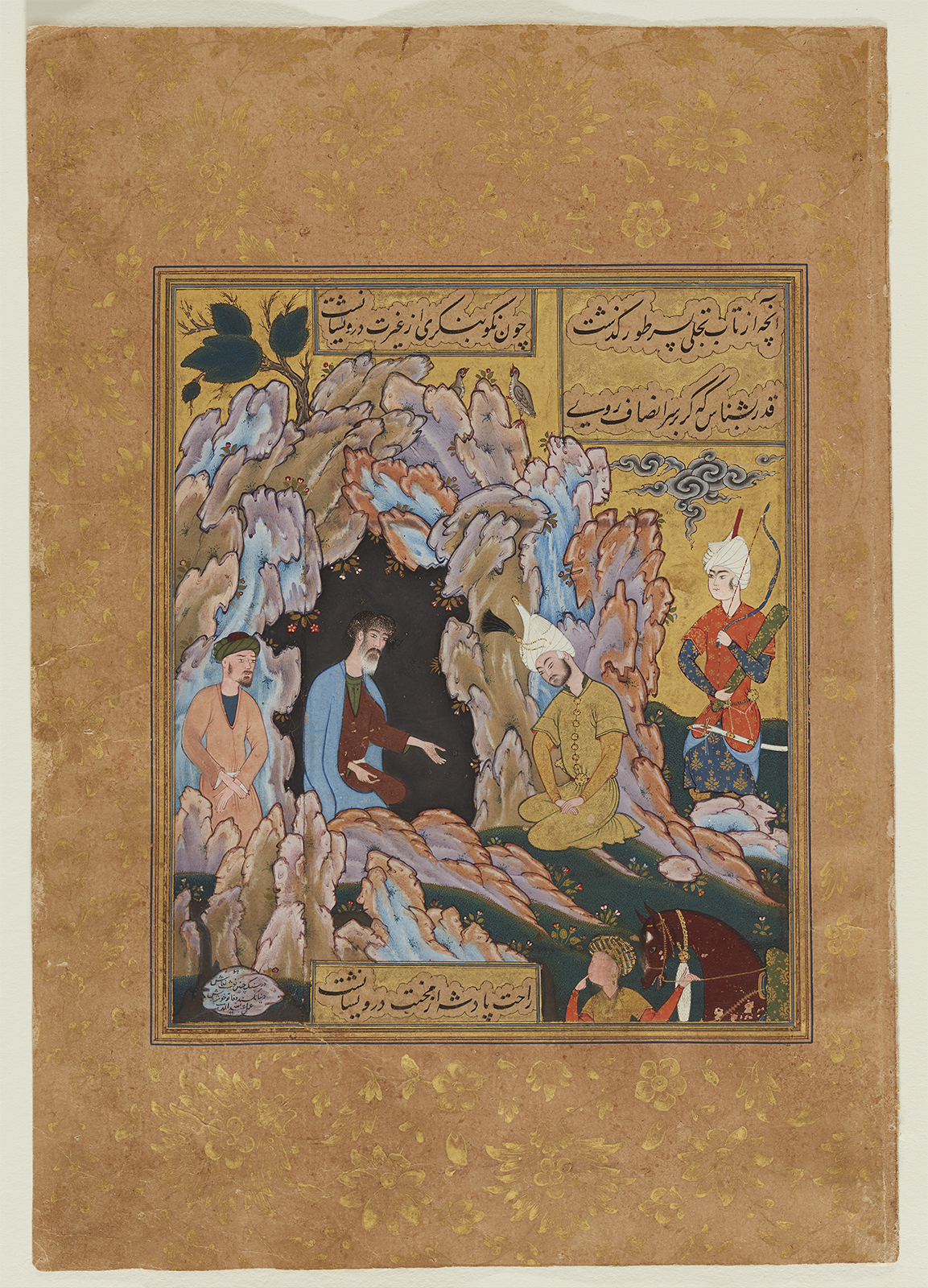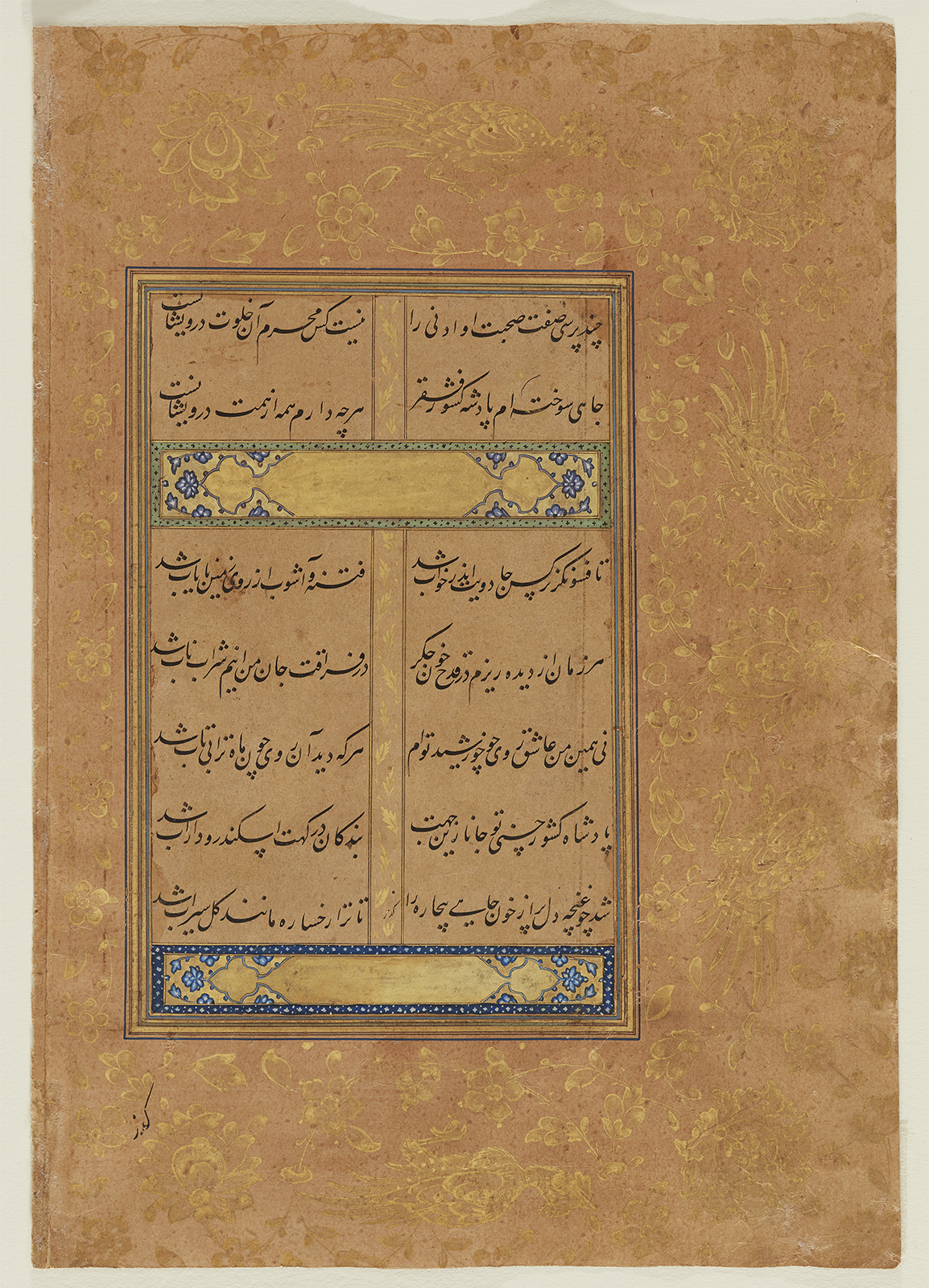Click on the image to zoom
A Prince Visits a Dervish
Folio from a manuscript of the Collected Works (Divan) of Sultan Ibrahim Mirza (fol. 23)
- Accession Number:AKM282.23
- Creator:Artist (calligrapher): `Abdullah al-Muzahhib
Artist (painter): `Abdullah al-Muzahhib
Compiled by: Gawhar Shad
Poet: Sultan Ibrahim Mirza, Persian, 1540 - 1577 - Place:Iran, Qazvin
- Dimensions:23.9 cm x 16.8 cm
- Date:1582-83 CE/990 AH
- Materials and Technique:opaque watercolour, ink, gold and silver on paper
This second illustration in the volume of poetry, or Divan, written by the Safavid prince Sultan Ibrahim Mirza (who wrote under the pen name of Jahi) is the only painting signed by a known court artist. That ‘Abdullah al-Shirazi was deeply involved in the production of the Divan manuscript as a whole, however, is attested by his microscopic signature in the thin band that surrounds the central fields on the opening illuminated frontispiece (see AKM282.1). Whereas there, ‘Abdullah clearly wanted to hide his presence (possibly as an artistic conceit), he signed and dated this composition on a large and distinctively-shaped rock in the left foreground and emphasized the rock’s prominent placement, materiality, and relationship to the painting’s subject with a long (and virtually unprecedented) inscription:
On this stone the painter has written that the world lacks constancy:
therefore be happy. Work of ‘Abdullah al-mudhahib [the illuminator],
the year 99[0]/158[2]-8[3]. [1]
Further Reading
‘Abdullah al-Shirazi worked for Sultan Ibrahim Mirza during the prince’s governorship in Mashhad and contributed to the illumination—and perhaps also the illustration—of a beautiful copy of the Haft Awrang (Seven Thrones), his patron’s most celebrated commission, in 1556–65. The artist accompanied Sultan Ibrahim Mirza to the Safavid capital of Qazvin in December 1574; following the prince’s assassination in February 1577, ‘Abdullah left court service and returned to Mashhad, where he served as an attendant at the tomb of his late patron. That he did not actually abandon artistic activities is obvious from his work on two different copies of Sultan Ibrahim Mirza’s Divan: this one of 1582–3 belonging to the Aga Khan Museum, and another, dated a year earlier, in Tehran’s Gulistan Library. ‘Abdullah presumably took on the illumination and illustration of these volumes as a memorial to Sultan Ibrahim Mirza and at the behest of the prince’s daughter Gawhar-Shad Begum.
The subject of ‘Abdullah’s painting, a prince visiting a dervish in a hermit-like setting, appears often in deluxe Safavid manuscripts of diverse poetic texts. Indeed, ‘Abdullah very likely based his composition on a more expansive illustration, created two or so decades earlier, for Sultan Ibrahim Mirza’s volume of the Haft Awrang by the great Persian poet Abdu’l-Rahman Jami. The relevant passage of Jami’s poem recounts how, to save his soul, a powerful monarch becomes the pupil of a pious dervish or Sufi mendicant and brings the ascetic many gifts. The dervish rejects all these presents because in his eyes, the king lives by tyranny: nothing he does is right and nothing he touches is pure. The poem by Sultan Ibrahim Mirza which ‘Abdullah’s painting accompanies strikes a similar chord, even mentioning the “retreat of dervishes” (that is, the hillside cave depicted here). It ends on a personal note:
[O] Jahi, I have been consumed. [O] King of the land of poverty:
Whatever I have, it’s all from the endeavors of dervishes.
This compact illustration concentrates on the same principle figures found in other paintings of the same scene: the hermit dervish, the prince, a humble disciple standing to the left of the cave’s entrance, an armed attendant behind the prince, and a horse and groom below. ‘Abdullah has devoted particular attention to the hillside setting and rendered the outcropping in mottled tones of purple, blue, orange, and brownish green. He also “carved” numerous human profiles into the rocks’ facets—a favourite motif in Safavid painting [2]—adding an other-worldly dimension to the scene.
— Marianna Shreve Simpson, in collaboration with Chad Kia
Notes
[1]. For more about ‘Abdullah al-Shirazi, see Simpson 1997, 154 and 300–7. See also Marianna Shreve Simpson, “Who’s Hiding Here? Artists and their Signatures in Timurid and Safavid Manuscripts,” Affect, Emotion, and Subjectivity in Early Modern Muslim Empires: New Studies in Ottoman, Safavid, and Mughal Art and Culture, ed. Kishwar Rizvi (Leiden and Boston: Brill, 2018): 58–60.
[2] Bernard O’Kane, “Rock Faces and Rock Figures in Persian Painting,” Islamic Art 4 (1990–91): 219–46.
References
O’Kane, Bernard. “Rock Faces and Rock Figures in Persian Painting,” Islamic Art 4 (1990- 91): 219–46. ISBN: 9780199215010
Simpson, Marianna Shreve. “Who’s Hiding Here? Artists and their Signatures in Timurid and Safavid Manuscripts,” Affect, Emotion, and Subjectivity in Early Modern Muslim Empires: New Studies in Ottoman, Safavid, and Mughal Art and Culture, ed. Kishwar Rizvi. Leiden and Boston: Brill, 2018, 45–65. ISBN: 9789004352841
---, with contributions by Massumeh Farhad. Sultan Ibrahim Mirza’s Haft Awrang: A Princely Manuscript from Sixteenth-Century Iran. Washington, DC: Freer Gallery; New Haven and London: Yale University Press, 1997. ISBN: 9780300068023
Note: This online resource is reviewed and updated on an ongoing basis. We are committed to improving this information and will revise and update knowledge about this object as it becomes available.




